Anchored off Lewoleba on the island of Lembata, Indonesia

Peregrina's Journey
Peter and Margie Benziger
Wed 10 Aug 2011 11:41
Position Report – 08:22.200S 123:24.500E
Hey Mister!! Hey, Mrs.!!!
It’s the universal greeting all across the Indonesian archipelago
which includes over 17,000 islands and meanders almost 5000km across the
equator from West Timor to Sumatra.
Everywhere you go, children and, often, adults as well call out “Hey
Mister!!, Hey Mrs.!!!” with welcoming smiles and a burst of giggles whenever the
“foreigner” attempts to respond with a bungled version of good morning –
“Selamat Pagi”, good afternoon –
“Selamat Sore”, or good evening – “Selamat Malam.”
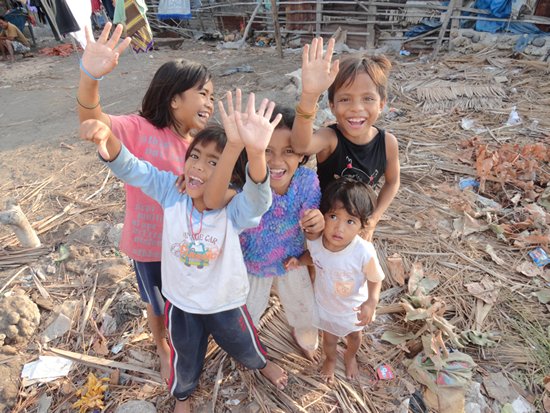
We arrived in Lembata after several days on the islands of
Kupang and Alor. It’s a pleasant change
from the hustle and bustle of the two previous stops as the main town here,
Lewoleba, is pretty laid back and life is centered around a street market which
comes alive every afternoon around 4pm with the arrival of the daily fish catch
and an abundance of fruits and vegetables.
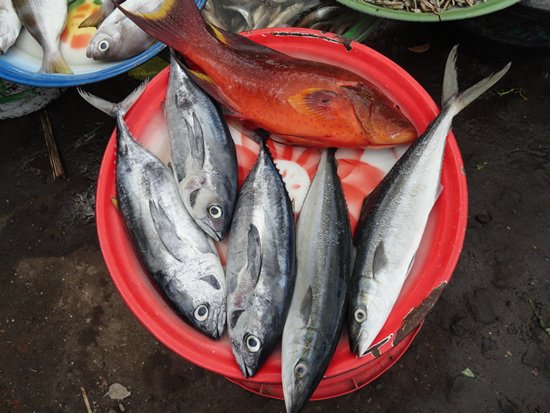
The presence of approx. 30 sailboats in the harbor and
almost 70 sailors walking about town caused quite a commotion amongst the
residents. You see, Lembata normally
welcomes only about 200 tourists every year and many never even make it to our
base here in Lewoleba. As we walk down
the main street in town, there is almost a side-show atmosphere surrounding our
presence but the locals are unfailingly polite, infinitely curious and
unbelievably friendly.

Lembata is best known for its smoking volcano, Ili Api, (pictured above with the catamaran, Swanie, in the foreground) and the whaling village of
Lamalera on the south side of the island where, for centuries, the men of the
village have been hunting whales with nothing more than bamboo-shafted harpoons
and spears á la Moby Dick. It’s said to
be the last place on earth where humans can still hunt whales by hand and is a
subsistence livelihood that conservation groups have exempted from the
international ban on whaling. On
average, the men of Lamalera take between 15-25 sperm whales each season and
that supposedly does not threaten sperm whale numbers which are estimated at
over 1million worldwide.
While the cultural/historical significance of the whaling
community intrigued us, the possibility of a long, harrowing, bloody experience
for the whale was a bit too much for Margie to witness and we opted for an
alternative shore excursion to the remote village of Petuntawa.
So, yesterday morning, a group of approximately 25 sailors
boarded two buses (No AC and definitely no shock absorbers) for the bumpy two-hour
ride to the north coast of the island. Now,
I have to say that Peter and I are not usually ones to sign up for these so-called cultural
excursions to a “traditional” village. In heavily trafficked tourist centers, these weekly, sometimes daily, “cultural extravaganzas” are likely to include a group of
outlandishly-costumed, overly-bored dancing automatons who perform in what is usually a “replica” of a traditional village from days gone by.
Not so, here in Petuntawa…
Our bus ride left the paved roads of Lewoleba after about 30
minutes and for the next hour and a half, we followed a pothole strewn, washed
out dirt road to the little village of Petuntawa. Here we were welcomed by a group of dancers
and greeted ceremoniously by the “mayor” of the town as well as several of the
“elders” from the town council. We were
offered palm wine and hand rolled cigarettes made from Lontar leaves and then
escorted through the town by the dancers and their drummers.
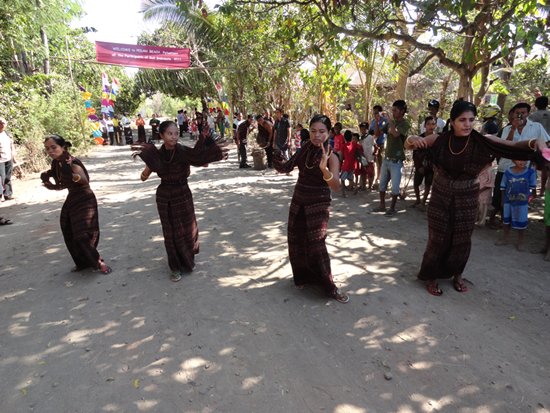
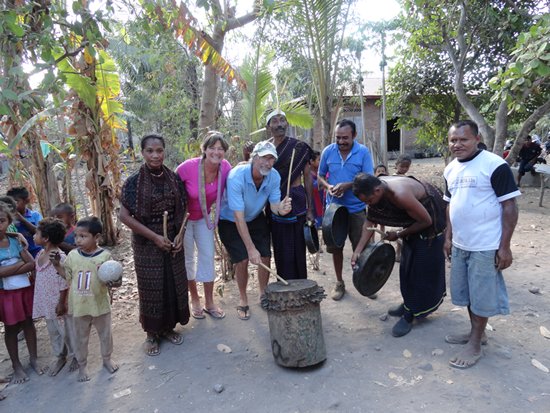
The streets were lined with people yelling
“Hey Mister, Hey Mrs.” and throngs of children surrounded us and held our hands
as we passed through the village. It was quite obvious that the sight of 25
fair-skinned foreigners was not a common occurrence in these parts.
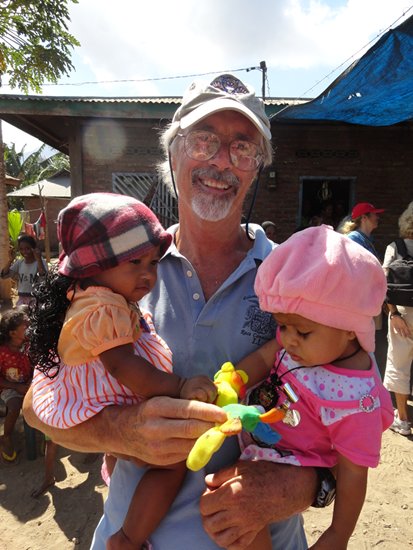
We witnessed a “Penang Ceremony” where the family of the
prospective groom marches through the streets with ivory tusks, golden jewelry,
hand-woven Ikat fabric, goats, chickens, pigs, fruits and vegetables as a dowry
to be presented to the bride’s family. Then we watched in awe as the older women in the village
showed us how they make the beautiful hand-spun Ikat weavings. After planting and harvesting the cotton, it
is cleaned and spun with a spindle.
Then, dyes are made from bark, roots and leaves. The cloth is woven on a loom and sections
that are not to be colored are bound together with dye resistant fibre. Each section of color represents a separate tying
and dyeing process and it is incredibly complicated. After watching this labor intensive art form,
we have a whole new appreciation for handiwork of this caliber.


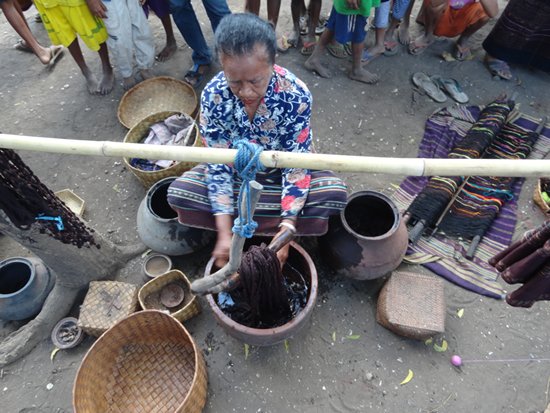
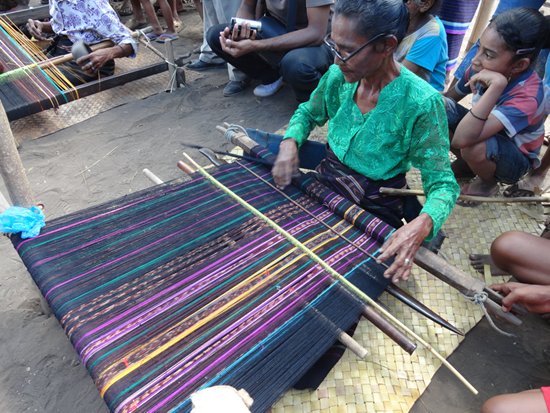
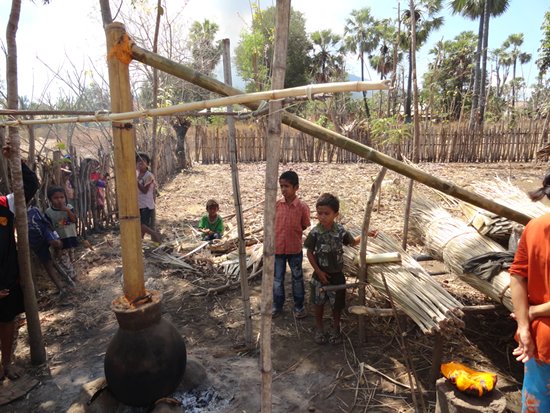
We then moved on to the beach for a terrific lunch with
fresh fish, rice, vegetables and curried chicken followed by another beautiful
dancing demonstration including a traditional bamboo pole dance with incredibly
intricate footwork.
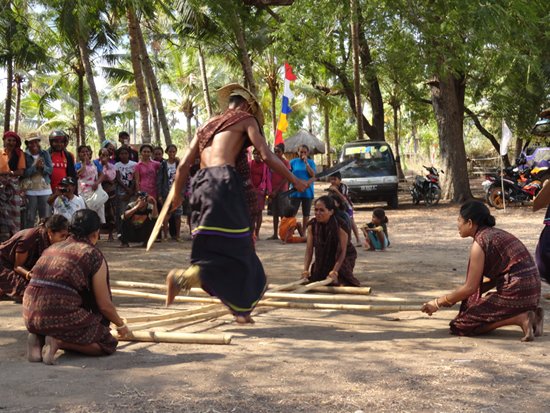
After the formal presentation was over, the dancers and many
of the villagers who had gathered around us seemed as if they didn’t want the
party to end. They encouraged the drummers to “strike up the band” over and
over again and everyone found a partner amongst the spectators and we all
danced together in a circle. It was
quite amazing. I’m not sure who got more
out of this outing, the sailors or the villagers. We were separated by a complex language
barrier yet their desire to make a connection with us was so strong you could
feel the good intentions and the pleasure they derived from showing us their way
of life.
On the way back to the bus, two little girls held on to my
hand tightly and patiently taught me how to count to ten in Bahasa
Indonesian. I reciprocated with the
English translation of the numbers. We
spied two horses in a field and I said “two horses” to which they replied “dua
gouda.” (sp?) I boarded the bus and
quickly grabbed my backpack which had a bunch of crayons and notebooks
inside. I opened the window where my two
little friends were standing below and handed them each a crayon and a
notebook. You would have thought I gave
them a million rupiah! As the bus pulled
away, they ran alongside saying “Hey Mrs!!!
Hey, Mrs!!! Selamat jalan! (Goodbye) and Terima Kasih! (Thank you)
No little girls...it is me who should be thanking you!